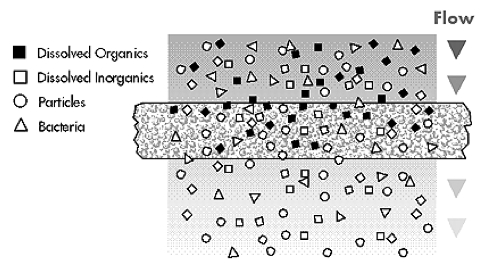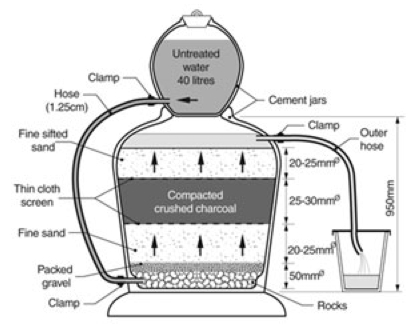Difference between revisions of "Charcoal filter / Activated carbon"
| Line 1: | Line 1: | ||
{{stub}} | {{stub}} | ||
[[Image:Ceramic_filter_icon.png|right]] | [[Image:Ceramic_filter_icon.png|right]] | ||
| − | |||
[[Image:charcoal filter.jpg|thumb|right|250px|The Unicef upflow charcoal filter. <br>Photo: WHO.]] | [[Image:charcoal filter.jpg|thumb|right|250px|The Unicef upflow charcoal filter. <br>Photo: WHO.]] | ||
[[Image:activated carbon filter.jpg|thumb|right|250px|Carbon Adsorption Diagram. Credit: [http://www.filtersfast.com/articles/Guide-to-Water-Purification.php filternfast.com]]] | [[Image:activated carbon filter.jpg|thumb|right|250px|Carbon Adsorption Diagram. Credit: [http://www.filtersfast.com/articles/Guide-to-Water-Purification.php filternfast.com]]] | ||
| Line 7: | Line 6: | ||
'''Charcoal''' can be quite effective at removing some tastes, odours, and colour. Ordinary charcoal available locally could be used, but activated carbon is more effective. An example of such a filter is the UNICEF upflow sand filter. However, if the charcoal is not regularly renewed or if the filter is left unused for some time, there is evidence that it can become the breeding ground for harmful bacteria. | '''Charcoal''' can be quite effective at removing some tastes, odours, and colour. Ordinary charcoal available locally could be used, but activated carbon is more effective. An example of such a filter is the UNICEF upflow sand filter. However, if the charcoal is not regularly renewed or if the filter is left unused for some time, there is evidence that it can become the breeding ground for harmful bacteria. | ||
| − | '''Activated carbon''' filters have a porous surface which traps microscopic particles and large organic molecules. The activated surface areas cling to (adsorb) smaller organic molecules. There are two basic types of activated carbon filters: granular and solid block. Granular activated carbon is most commonly used in household drinking water filtration products. These are easy to install and inexpensive. They significantly reduce bad taste and odor caused by gases and chemicals like chlorine and its byproducts, while leaving behind natural minerals that are essential to good health. Depending on micron size, they may also remove some microorganisms. Solid block carbon filters have a solid honeycombed structure. These are usually whole-house filters, installed directly into the house water supply. They are more expensive than granular activated carbon filters but require less frequent installation, and they reduce more chemicals including pesticides. | + | '''Activated carbon''' filters have a porous surface which traps microscopic particles and large organic molecules. The activated surface areas cling to (adsorb) smaller organic molecules. There are two basic types of activated carbon filters: granular and solid block. Granular activated carbon (GAC) is most commonly used in household drinking water filtration products. These are easy to install and inexpensive. They significantly reduce bad taste and odor caused by gases and chemicals like chlorine and its byproducts, while leaving behind natural minerals that are essential to good health. Depending on micron size, they may also remove some microorganisms. Solid block carbon filters have a solid honeycombed structure. These are usually whole-house filters, installed directly into the house water supply. They are more expensive than granular activated carbon filters but require less frequent installation, and they reduce more chemicals including pesticides. |
| − | Carbon can be obtained from a variety of sources such as coconut shell, wood or coal, and all of which are readily available practically everywhere in the world. The activation process is also quite simple and can be done with an industrial oven. Although carbon blocks have a higher contaminate removal ratio, granulated activated carbon are more commonly used in home filter systems. Activated carbon bits cannot be reused and need to be replaced after filtering about 150L of water. | + | Carbon can be obtained from a variety of sources such as coconut shell, wood or coal, and all of which are readily available practically everywhere in the world. Activated carbon prepared from local agroforestry waste residues such as macadamia nut shells, baobab shells and marula fruit stones is effective in the removal of heavy metal ions from aqueous solution. The activation process is also quite simple and can be done with an industrial oven. Although carbon blocks have a higher contaminate removal ratio, granulated activated carbon are more commonly used in home filter systems. Activated carbon bits cannot be reused and need to be replaced after filtering about 150L of water. |
==Acknowledgements== | ==Acknowledgements== | ||
| Line 15: | Line 14: | ||
* [http://www.filtersfast.com/articles/Guide-to-Water-Purification.php A Simple Guide to Water Filtration.] Filtersfast.com | * [http://www.filtersfast.com/articles/Guide-to-Water-Purification.php A Simple Guide to Water Filtration.] Filtersfast.com | ||
* Chan, Louis; Chan, Marcus; Wang, Jingwen. [http://www.google.com/url?sa=t&rct=j&q=&esrc=s&source=web&cd=2&ved=0CFoQFjAB&url=http%3A%2F%2Fwww.mie.utoronto.ca%2Fundergrad%2Fthesis-catalog%2Ffiles%2F12.pdf&ei=-KX7T-evCIqO2wWO05jABg&usg=AFQjCNH1KomG6m3ZKkzZqQkw2n_RkGJObA&sig2=tO15bbIUkrVPWY1spxHy4A Design of Water Filter for Third World Countries.] March 26th, 2009. | * Chan, Louis; Chan, Marcus; Wang, Jingwen. [http://www.google.com/url?sa=t&rct=j&q=&esrc=s&source=web&cd=2&ved=0CFoQFjAB&url=http%3A%2F%2Fwww.mie.utoronto.ca%2Fundergrad%2Fthesis-catalog%2Ffiles%2F12.pdf&ei=-KX7T-evCIqO2wWO05jABg&usg=AFQjCNH1KomG6m3ZKkzZqQkw2n_RkGJObA&sig2=tO15bbIUkrVPWY1spxHy4A Design of Water Filter for Third World Countries.] March 26th, 2009. | ||
| + | * Misihairabgwia, Jane, Ntulia, Victor, et al. [http://www.google.com/url?sa=t&rct=j&q=&esrc=s&source=web&cd=4&ved=0CF8QFjAD&url=http%3A%2F%2Fbscw.ihe.nl%2Fpub%2Fnj_bscw.cgi%2Fd2607370%2FMisihairabgwi.pdf&ei=Sqz7T8TEE4aE2wWDqLzKCw&usg=AFQjCNEPy6ngbVmEshDEu2sG5NB5Ozgx_A&sig2=U-4xat4ouUcyYAL4xp17EA Application of locally produced activated carbons in water treatment.] Department of Biochemistry, University of Zimbabwe. | ||
Revision as of 06:23, 10 July 2012
| |

Charcoal can be quite effective at removing some tastes, odours, and colour. Ordinary charcoal available locally could be used, but activated carbon is more effective. An example of such a filter is the UNICEF upflow sand filter. However, if the charcoal is not regularly renewed or if the filter is left unused for some time, there is evidence that it can become the breeding ground for harmful bacteria.
Activated carbon filters have a porous surface which traps microscopic particles and large organic molecules. The activated surface areas cling to (adsorb) smaller organic molecules. There are two basic types of activated carbon filters: granular and solid block. Granular activated carbon (GAC) is most commonly used in household drinking water filtration products. These are easy to install and inexpensive. They significantly reduce bad taste and odor caused by gases and chemicals like chlorine and its byproducts, while leaving behind natural minerals that are essential to good health. Depending on micron size, they may also remove some microorganisms. Solid block carbon filters have a solid honeycombed structure. These are usually whole-house filters, installed directly into the house water supply. They are more expensive than granular activated carbon filters but require less frequent installation, and they reduce more chemicals including pesticides.
Carbon can be obtained from a variety of sources such as coconut shell, wood or coal, and all of which are readily available practically everywhere in the world. Activated carbon prepared from local agroforestry waste residues such as macadamia nut shells, baobab shells and marula fruit stones is effective in the removal of heavy metal ions from aqueous solution. The activation process is also quite simple and can be done with an industrial oven. Although carbon blocks have a higher contaminate removal ratio, granulated activated carbon are more commonly used in home filter systems. Activated carbon bits cannot be reused and need to be replaced after filtering about 150L of water.
Acknowledgements
- Emergency treatment of drinking water at point-of-use. WHO.
- A Simple Guide to Water Filtration. Filtersfast.com
- Chan, Louis; Chan, Marcus; Wang, Jingwen. Design of Water Filter for Third World Countries. March 26th, 2009.
- Misihairabgwia, Jane, Ntulia, Victor, et al. Application of locally produced activated carbons in water treatment. Department of Biochemistry, University of Zimbabwe.

